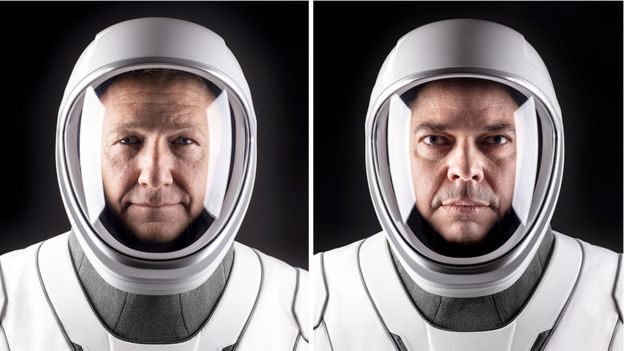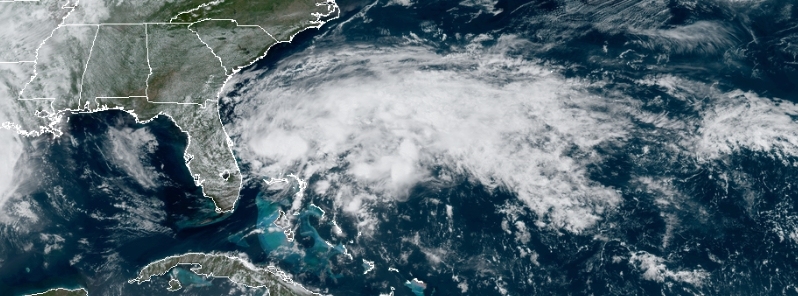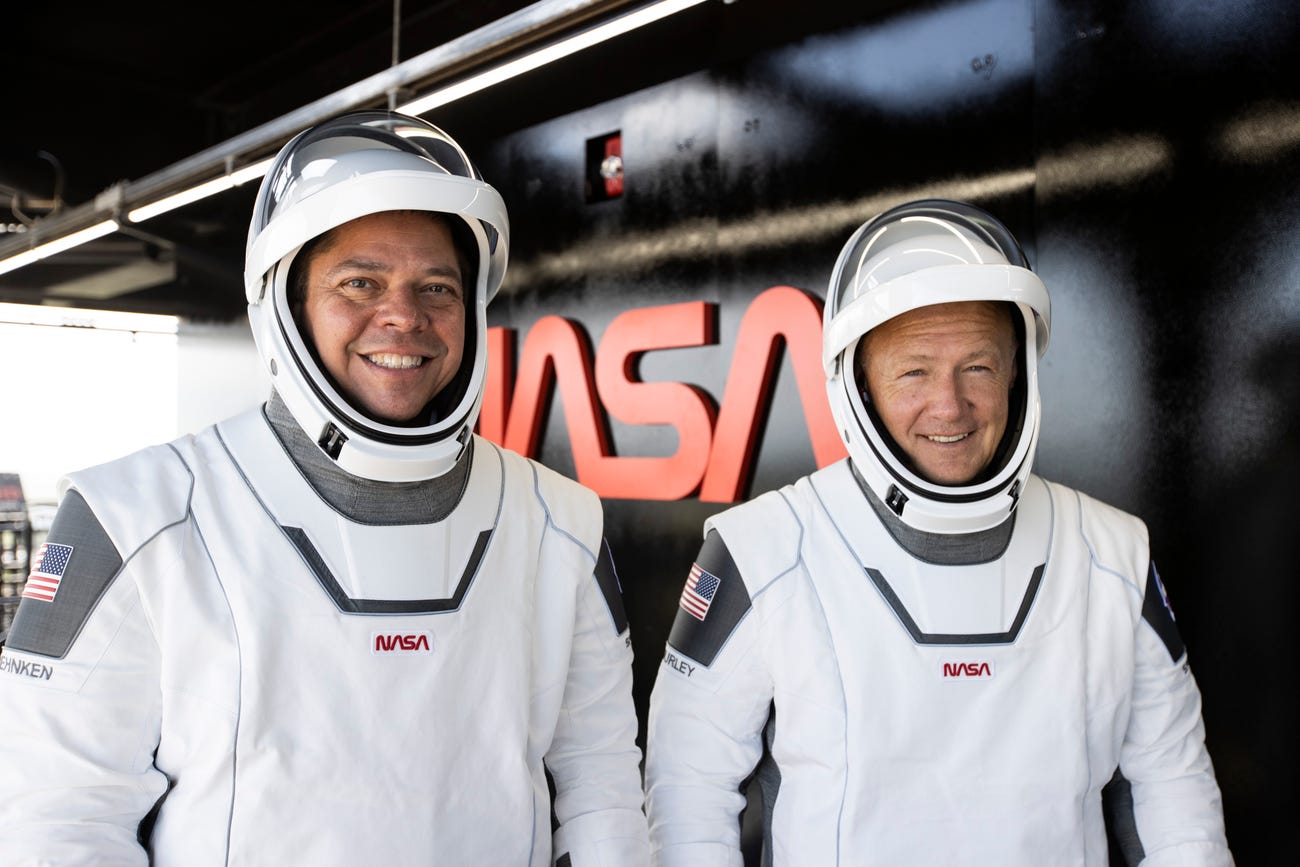If weather conditions allow two astronauts to test new rocket innovation, millions of people across the world will witness history being made as NASA proves Space X’s new design as a success in regards to new human space flight. Today, SpaceX’s Crew Dragon Demo-2 mission is a flight test with a human crew geared to certify if NASA can use a SpaceX vehicles for operational missions to the International Space Station (ISS). NASA astronauts Robert Behnken and Douglas Hurley will fly on the Crew Dragon spacecraft, lifting off on a Falcon 9 rocket from the Kennedy Space Center in Florida at Launch Complex 39A.
Crew Dragon is a human-rated capsule that can transport up to seven astronauts. If the flight launches successfully, NASA will potentially use a new system to deposit payload into space with astronauts. Such payloads have been mainly satellites used for high speed wireless communications and parts for the International Space Station (ISS) used by countries around the world. Traditionally, NASA has always used and operated their own rockets and vehicles to enter orbit. NASA previously used Apollo, and the Space Shuttles for human flight. The last “manned-Flight” rated Space Transportation System (STS) was NASA’s Space Shuttle. Operating from 1981 to 2001, the last NASA Space Shuttle launch was STS-135 in 2011.

Space shuttle Atlantis stands on Launch Pad 39A at NASA’s Kennedy Space Center in Florida, where liftoff on STS-135, the final shuttle mission. Image courtesy of NASA.
INSPIRATION: Two Humans Give Their Lives to Science

Doug Hurley (L) and Bob Behnken (R) are the test pilots giving their lives for science as test pilots. Image courtesy of NASA.
Two pilots are testing the high-powered Falcon 9 rockets and are expecting to successfully control the operations of the Crew Dragon Demo-2 mission. Astronauts Doug Hurley and Robert Behnken will be aboard the rocket to the International Space Station. The mission is expected to be a success in certifying the spacecraft before it begins regular service. Each astronaut has extensive flight history. The mission will take Behnken and Hurley to the International Space Station, where they will dock and stay for several weeks.
Douglas Gerald Hurley is an American engineer, former Marine Corps pilot, and current NASA astronaut. He piloted Space Shuttle missions STS-127 and STS-135, the final flight of the Space Shuttle program. He is scheduled to command Crew Dragon Demo-2, the first crewed spaceflight from American soil since STS-135.
In July 2011, Hurley returned to space on STS-135 on the Space Shuttle Atlantis. The mission delivered the Multi-Purpose Logistics Module (MPLM) Raffaello and a Lightweight Multi-Purpose Carrier (LMC) to the international space station, as well as tested a system which investigated robotically-refueled spacecrafts.
Robert Louis “Bob” Behnken is a NASA astronaut, engineer and former Chief of the Astronaut Office. Behnken holds a Ph.D in Mechanical Engineering and the rank of Colonel in the U.S. Air Force, where he served before joining NASA in 2000. Behnken was a crew member of the STS-123 mission that delivered the Japanese Experiment Module and the Special Purpose Dexterous Manipulator to the International Space Station in March 2008. Behnken took part in three spacewalks during the mission. For STS-130, Behnken flew to space for the second time as a Mission Specialist and delivered the Tranquility module and Cupola to the International Space Station.
On average NASA astronauts endure a rigorous nine-year training program geared to understand all the NASA engineering. From the vehicles to the engineering of the payloads, they physically endure pressures exhibited on the human body when traveling to Space. The human body must be trained, over many years, to withstand the force exerted on the human body and maintain consciousness along with coherent thinking as gravitational forces pound upon the human chest and possibly restrict the body’s blood flow. To add, each astronaut is responsible for knowing the risks of space flight, and all catastrophic exit scenarios if the rocket experiences unplanned explosions. Test pilots literally donate their lives to science and place their human lives in the hands of the men and women in Mission Control.
THE NEW APPROACH: Private Companies Can Potentially Launch Humans
The launch also marks the first time that a private company, SpaceX — as opposed to the national government — is sending astronauts to space using a commercially developed spacecraft. A new era of human spaceflight can potentially begin. Unlike SpaceX’s previous rocket launches, SpaceX must demonstrate that humans can safely travel on the Falcon 9 rockets as part of the SpaceX Dragon Demo-2 system. NASA has a separate standard for human versus non-human space flight transportation. The human certification process includes successful “Return to Launch Site” plans if the rockets should fail. If such scenario were to occur, test pilots must survive during the risky landing. With the expectation of success, SpaceX engineers must ensure that all safety and reliability requirements are met, and SpaceX must create a system that is reliable like the previous Space Shuttle launches.
THE RISK: The Weather & A Pandemic

Weather has become a major concern for the first-human-crewed mission from U.S. soil in nine years. The projected liftoff has a 60 percent of violating weather constraints because of thick cloud cover with the likelihood that their SpaceX Falcon 9 rocket would fly through rain. The ship was already postponed due to a Tropic Storm Arthur earlier this May.
Clouds must be a specific distance away from the launch site. Some dense clouds may look innocent, but their contents are deadly. At the bottom of these cloud, there is gaseous water. However, at higher altitudes, the top of such clouds can hold solid icebergs that float in the atmosphere. And if rockets were to travel through such ice masses, the outcome would be equivalent to the Titanic hitting an iceberg. Though, the speeds are significantly re-scaled for space travel.
To achieve orbit in the past, the Space Shuttle had to accelerate from zero, to a speed of almost 18,000 miles per hour within roughly the first minute. This speed is nine times as fast as the average rifle bullet. A dense cloud within a 5-10 mile radius of the launch site could potentially halt the SpaceX’s Crew Dragon Demo-2 in a fiery explosion.
Due to the 2020 Pandemic, no matter what, NASA officials do not want large groups of travelers gathering in the Florida area who can potentially set off another COVID-19 outbreak. The head of NASA is urging space enthusiasts not to show up in person. The historic launch will be broadcast online, and NASA officials encourage the general public to watch astronauts Douglas Hurley and Robert Behnken online and on NASA TV.
We all pray that Doug Hurley and Bob Behnken remain safe.
Until next time, find me on the following sites:
- OlympiaLePoint.com
- Instagram.com/OlympiaLePoint
- facebook.com/OlympiaLePoint
- Twitter.com/OlympiaLePoint
- LinkedIn.com/in/olympialepoint
Sincerely,
Olympia LePoint
Rocket Scientist & Author


